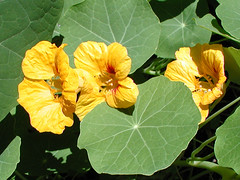All of our food derives from the sun. Plants need the sun to perform photosynthesis, animals eat the plants, and we eat both. I know, of course, that there are some organisms that live way deep down in the ocean, and others that live in caves and the like. But the ones in the oceans consume organisms that have been higher up. Plants in caves at least get nutrients from the air that have come there because of solar conversions of nutrients.
We've all seen pictures of the sickly chickens whose entire life is spent indoors in cages. The yolks of their eggs are uniformly yellow because of chemical additives. Chickens who have access to the outdoors and green plants tend to have paler yolks in the winter and brighter ones in the summer, reflecting the amount of sunlight that has reached their food.
I am reading an interesting book these days: Introduction To Air in California
One thing I read here (and in the Feb/March 2007 National Wildlife magazine) is that more CO2 might produce bigger plants, but probably not better ones. The amount of other nutrients will remain the same, so animals (and we) will have to eat more to get the same nutritional value.
The article also says that plants like ragweed and poison ivy will produce more pollen and toxins, making life more miserable for those of us who cannot tolerate these.











No comments:
Post a Comment